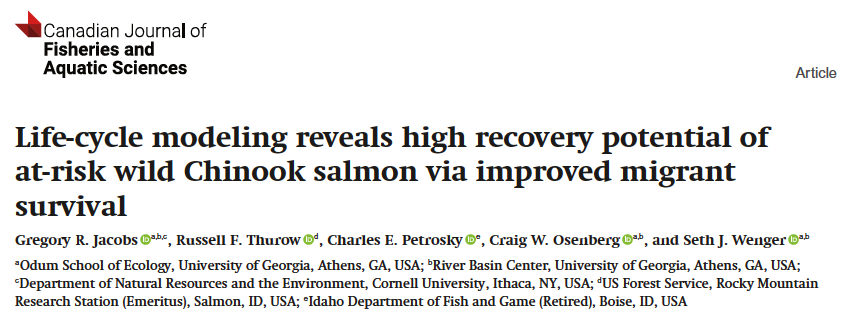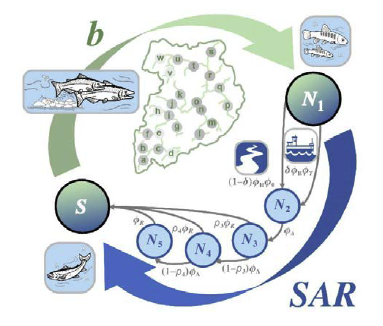
 (pdf) Abstract. Chinook salmon (Oncorhynchus tshawytscha) in the Columbia River basin are threatened by anthropogenic changes to migratory corridors, estuaries, and natal habitats. Streams provide spatially heterogeneous natal habitats essential for salmon spawning and rearing life stages. We fit a statistical state-space model to salmon populations in Idaho’s Middle Fork Salmon River (MFSR) to assess spatial variation in natal productivity and population growth. Our model integrated multiple long-term data sets to estimate variation in per-capita smolt production and smolt-to-adult (SAR) survival. Smolt production varied across stream segments, averaging 104.48 female smolts per spawning female, while SARs averaged 0.74%. Chinook salmon population growth rates exceeded replacement in 17% of segments (4 of 23). By increasing SARs to 1.8% (near the lower bound of Columbia River basin recovery targets), we predict that all 23 MFSR segments will yield positive population growth rates at contemporary (very low) spawner densities. Our analysis suggests that for Snake River basin populations within high-quality natal habitats, SAR improvements will elevate salmon population growth rates and enhance restoration of at-risk wild Chinook salmon.
(pdf) Abstract. Chinook salmon (Oncorhynchus tshawytscha) in the Columbia River basin are threatened by anthropogenic changes to migratory corridors, estuaries, and natal habitats. Streams provide spatially heterogeneous natal habitats essential for salmon spawning and rearing life stages. We fit a statistical state-space model to salmon populations in Idaho’s Middle Fork Salmon River (MFSR) to assess spatial variation in natal productivity and population growth. Our model integrated multiple long-term data sets to estimate variation in per-capita smolt production and smolt-to-adult (SAR) survival. Smolt production varied across stream segments, averaging 104.48 female smolts per spawning female, while SARs averaged 0.74%. Chinook salmon population growth rates exceeded replacement in 17% of segments (4 of 23). By increasing SARs to 1.8% (near the lower bound of Columbia River basin recovery targets), we predict that all 23 MFSR segments will yield positive population growth rates at contemporary (very low) spawner densities. Our analysis suggests that for Snake River basin populations within high-quality natal habitats, SAR improvements will elevate salmon population growth rates and enhance restoration of at-risk wild Chinook salmon.